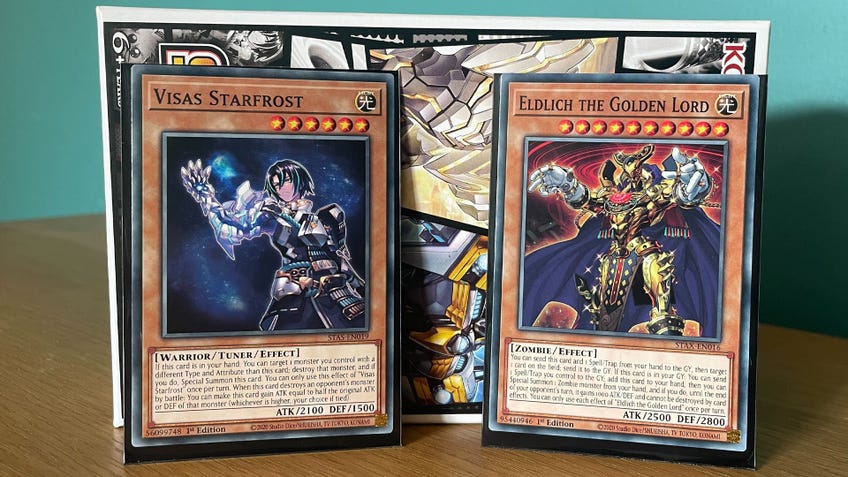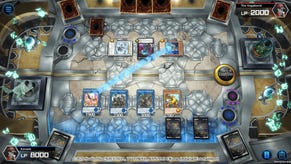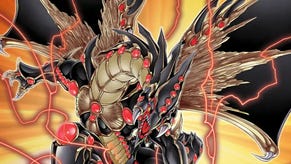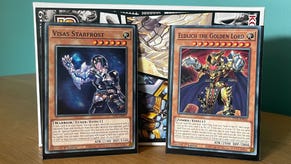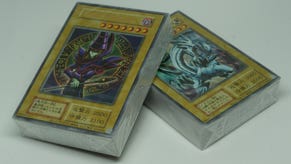Yu-Gi-Oh!’s new starter set is the easiest the TCG has been to learn in 25 years
The step-by-step intro to the card game’s dense rules is basic, but not boring.
Out of the big three trading card games - Magic: The Gathering, Pokémon and Yu-Gi-Oh! - Yu-Gi-Oh! is the most infamous for being intimidating for new players to pick up.
Pokémon’s one-on-one attach-energy-and-attack battles are straightforward - especially if you’ve played the video games, which it closely emulates - and while Magic: The Gathering can pack individual cards with a novel’s worth of rules text and keywords, its basic turns are all fairly simple.
In Yu-Gi-Oh!, meanwhile, even knowing how to get your cards onto the table can be an exercise in remembering which of several different summon types you’re supposed to use, and the unique rules and requirements that apply to each. That’s before you start chaining together the TCG’s legendary ‘OTK’ (One-Turn Kill) combos, which can see a player bring back cards from their graveyard, spring traps and spells laid turns before, exchange cards for ever-more powerful monsters, and unleash attacks that can reduce a player from their starting life point total to a smouldering crater of cardboard in a single turn - sometimes even on their first turn.
Those combos and complex summons are all part of the appeal, of course, and make Yu-Gi-Oh! in many ways the ultimate form of the trading card game; with a perfectly-crafted deck, the skill of your timing and the luck of the draw, you can perform the impressive equivalent of an flawless victory combo in Street Fighter or an unbeaten killstreak run in Fortnite. At its best, it’s easy to see why it’s remained such a popular game for a quarter-century and inspired pro-level tournaments watched by thousands.
Yu-Gi-Oh!’s 2-Player Starter Set is an attempt to bridge the gap between the hands-off rules management of Master Duel and the detailed-to-a-fault rulesheets of old.
Even if other factors have lowered the bar to entry, getting into Yu-Gi-Oh! nowadays can still be tough. Even if you approach the game through slick digital apps like Master Duel, the automation of the rules, speed of play and complex multi-step combos can make it hard to really understand exactly what’s going on at any moment, especially when you start running up against deeper pulls from the game’s 10,000-plus-strong catalogue of different cards from the last 25 years. The video games might stop you from accidentally breaking any rules, but they don’t necessarily help you understand how to use those same rules to your advantage and become a better player without a lot of trial and error (and crushing defeats).
In contrast, the rules sheet included with the game’s traditional starter decks provides a fairly comprehensive overview of how everything works, but without the benefit of seeing it in practice. The onus is on the player to sift through all the rules and work out which apply to the particular deck they’re using, or that of their opponent. It’s often overwhelming, without needing to be - if nobody is using Pendulum summons, trying to hold that information in your head during your first duel can distract from simply enjoying the match playing out in front of you and learning how to alchemise the cards you do have into a winning strategy.

Yu-Gi-Oh!’s new 2-Player Starter Set is an attempt to bridge the gap between the hands-off rules management of Master Duel and the detailed-to-a-fault rulesheets of old, and marks a notable fresh approach for the trading card game in its 25th year. Rather than just handing players a deck of cards and rules separately, the starter set blends the two together, presenting a fully playable tutorial designed to run two players - or one person controlling two decks, if needs be - through the basics. (A copy of the 2-Player Starter Set was provided by Konami.)
This takes the form of two separate decks, pre-arranged into a specific order. (A card on top of each deck warns you not to shuffle them before playing, and they can be easily reset to repeat the tutorial.) The decks combine with a rulebook laid out like a comic book, adopting a friendly, conversational style rather than the dry technicality of conventional rules - with the visual format also nodding reverently at Yu-Gi-Oh!’s origins in the late Kazuki Takahashi’s manga.
The comic guides each player through the steps of a duel and basics of how to play Yu-Gi-Oh!, going from setup and drawing cards to Normal and Tribute summons, attacks, spells and traps. Later stages of the 64-page book gently introduce Special summons, plus two of Yu-Gi-Oh!’s more advanced summon types utilising a separate Extra Deck: Synchro and Xyz. Each of the players uses a unique 40-card deck (plus four Extra Deck cards) built around one of the two summon types, letting both see the rules in action without having to juggle too many different cards or rules by themselves.

The set deliberately skips over more complicated summoning types - notably Ritual and Pendulum - to keep its focus tight and accessible. The set’s self-aware nature (“It’s complicated,” it says knowingly of Pendulum summons), measured approach to rolling out rules a little at a time (some steps set up later turns, advising the player not to worry about the details until they need to) and lighthearted tone make it feel more like a friend taking you through the ropes. It’s basic in all the right ways, without being boring as a rules tutorial. In my experience, it was the ideal way to learn to play, and the most approachable the core Yu-Gi-Oh! rules have ever been for an enthusiastic on-and-off fan since my childhood 20 years ago.
The set’s self-aware nature, measured approach to rolling out rules a little at a time and lighthearted tone make it feel more like a friend taking you through the ropes.
The starter set deftly juggles nostalgia for returning players and the allure of shiny new cards making headlines at tournaments. Among the decks lurk classic cards familiar from the original anime such as Dark Magician and Swords of Revealing Light, along with popular new cards that have ruled the TCG’s competitive scene in recent years - and in some cases, continue to top major tournaments. Eldlich the Golden Lord, Divine Arsenal AA-ZEUS - Sky Thunder, Visas Starfrost and multiple Mannadium cards all show up, offering a sweet taster of Yu-Gi-Oh!’s more recent archetypes. (I was personally pleased to finally learn how to use Eldlich’s graveyard effect properly, having cloned a rankings-topping meta deck without really getting to grips with its mechanics during my time with Master Duel.)

With all of the cards in both decks being reprints of existing cards legal for tournament use, the tutorial leaves each player with a deck ideal for tweaking and shaping to fit their preferred play style - or upgrading into one of the TCG’s customisable structure decks, if they choose to dive in on a particular theme or mechanic. While neither deck is likely to take you to the World Championships, there’s plenty here to let you play satisfying duel after duel with friends before you need to invest in extra cards.
Rather than leave players having to reset and find their way through from the start, the comic book sets up both players with almost equal life points before it takes off the stabilisers, able to finish the rest of a duel using the rules they’ve just learned. With the tutorial itself playing out some exciting back-and-forths as spells pop, traps spring and life points go up and down, it’s a moreish taste of Yu-Gi-Oh! that really manages to get the hook into why the TCG has maintained such a passionate community of players across the decades.

While not every single rule is covered in depth, the rules that matter most are put across in a way that sticks. More than just how to play, the set teaches you why to play: the delight at tributing two of your monsters to bring out a whopping powerhouse or turning monsters into materials to unleash your Extra Deck all-stars, the joy of chaining together your effects to fill your board with monsters, the satisfaction of springing a trap on your opponent to negate or reverse their killer move. (Or, in my case, seeing your game-winning massive attack turned on you to hand the victory to your opponent. It was still fun!)
Rather than pretending it’s a one-and-done lesson, this starter set leaves you in anticipation of diving deeper into this wild, wonderful card game, and excited to learn all there is to know about it with the basics confidently in hand. I can’t imagine higher praise for a starter set than that.
